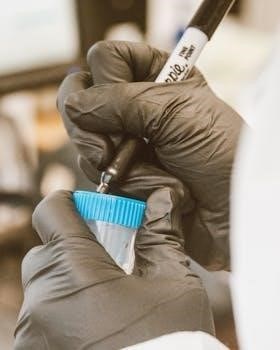A chemistry lab manual is a crucial resource, complementing textbooks and providing detailed instructions for experiments. It guides students through procedures, safety protocols, and data analysis. These manuals often include real-world applications, enhancing the learning experience. Lab manuals are essential for hands-on learning, offering practical experience in chemistry.
Ordering Student Lab Manuals
Student lab manuals are typically available for purchase through various channels, often including the College Board Store, which offers bound versions, not PDFs. These manuals are essential for students to engage in chemistry investigations. They provide detailed procedures and instructions for experiments, as well as information on using laboratory equipment. Students should check their course syllabus or their professor for specific instructions on where to obtain the correct lab manual for their chemistry courses. Many educational institutions or bookstore websites offer online ordering options for lab manuals and other required course materials. Ensure the manual is the correct edition for the current academic year. Some institutions may provide a digital version of the manual. If unavailable, students are advised to acquire a physical copy to properly follow the lab protocols and record their findings. Purchasing the required lab manual is often a prerequisite for participating in lab sessions and must be completed before the start of any lab work. Remember to always verify your order and purchase lab manuals from official or trusted sources.

IGCSE Chemistry Lab Manual
An IGCSE chemistry lab manual is specifically designed to align with the International General Certificate of Secondary Education curriculum. These manuals provide structured instructions for experiments, which are crucial for students to gain hands-on experience. These manuals typically offer a wide range of experiments, covering various topics within the IGCSE chemistry syllabus, which may include topics such as acids and bases, rates of reaction, organic chemistry, and quantitative analysis. The manual will include detailed procedures, safety guidelines, and space to record observations and results. The aim of the experiments is to develop essential practical skills, which are a key component of the IGCSE assessment. The IGCSE lab manual often serves as a guide for students throughout their studies and can be downloaded as a PDF or obtained as a physical book. It must be used with care and all instructions must be followed carefully. It is also crucial for teachers and students to verify that they are using the correct version of the lab manual. Access to a comprehensive and well-organized lab manual is critical for success in IGCSE chemistry practical assessments.
General Chemistry Laboratory Safety Rules
Safety in a general chemistry laboratory is paramount and adhering to safety rules is crucial to prevent accidents and ensure a secure learning environment. Students must wear appropriate personal protective equipment, which includes lab coats and safety goggles, at all times while in the lab. Eating, drinking, and applying cosmetics are strictly prohibited within the lab space to prevent accidental ingestion of chemicals. Familiarizing oneself with the locations of safety equipment such as fire extinguishers, eyewash stations, and first aid kits is essential. Before beginning any experiment, it is important to read and understand the procedures and safety precautions. Proper disposal of chemical waste is mandatory to prevent environmental contamination and must be followed according to instructions. Students should be aware of the hazards associated with the chemicals they will be using. Unauthorised experiments are strictly forbidden. All spills must be reported immediately so they can be cleaned up safely. In case of an emergency, the lab instructor should be notified immediately. Compliance with these rules is mandatory for every student and staff member working in the lab.

Importance of Lab Notebooks
Maintaining a detailed and accurate lab notebook is a cornerstone of scientific practice and crucial in any chemistry laboratory. A lab notebook serves as a primary record of all experimental work, including procedures, observations, and data. It allows scientists to track the progress of experiments and recreate them later if necessary. The notebook should be a detailed record of the methodology and any adjustments. All entries should be clear, concise, and written in permanent ink. It is also critical to include any unexpected observations or deviations from the planned procedure. The notebook should contain all relevant data, including measurements and calculations. The lab notebook is essential for documenting information that can be used in research. The entries should be in chronological order, and no pages should be removed or altered. Proper use of a lab notebook fosters a scientific approach and helps to develop critical thinking skills. A well maintained notebook is essential for generating reliable results and ensuring the integrity of the research. These notebooks must be kept safe and readily accessible.
Fume Hoods in Chemistry Labs
Fume hoods are essential safety devices in chemistry laboratories, designed to protect laboratory personnel from exposure to hazardous fumes and vapors. These hoods work by continuously drawing air away from the work area and expelling it outside the building, preventing the accumulation of toxic substances within the lab. It is crucial to always use the fume hood when working with volatile chemicals or conducting reactions that release fumes. Before starting any experiment, ensure the fume hood is functioning correctly. The hood’s sash should be kept at the appropriate height to maximize airflow and minimize exposure. Never place your head inside the fume hood while conducting experiments and always maintain a safe distance. Proper use of fume hoods is critical for maintaining a safe lab environment and preventing inhalation of harmful substances. The equipment must be regularly checked to ensure its proper functionality. Fume hoods are fundamental for the safe handling of chemicals and reactions. They provide essential protection and should always be used when handling potentially hazardous materials. Regular checks and maintenance are paramount.
Chemistry Lab Equipment and Facilities
Chemistry laboratories are equipped with a range of specialized equipment and facilities designed to support various experiments and research activities. Essential equipment includes glassware, such as beakers, flasks, and test tubes, used for containing and mixing chemicals. Analytical instruments like balances, spectrophotometers, and pH meters are crucial for precise measurements. Furthermore, labs often have access to specialized facilities such as fume hoods for safely working with volatile substances, and chemical stockrooms for the storage of materials. It is important for students to familiarize themselves with these instruments and facilities. Proper operation of equipment is important for accurate results. Additionally, labs should have adequate ventilation and safety equipment. A well-equipped lab is essential for conducting experiments safely and efficiently. Each piece of equipment plays a vital role in the laboratory setting. A stockroom for chemicals is essential to manage the lab’s chemical resources efficiently, and a proper waste disposal system is also crucial for safety and environmental reasons. Furthermore, instrumentation rooms are often necessary for the operation of more complex devices.
Basic Laboratory Techniques
Mastering basic laboratory techniques is fundamental to success in chemistry. These techniques include accurate measurement of mass using balances, and precise measurement of volume using graduated cylinders and pipettes. Proper handling of glassware, such as beakers, flasks, and test tubes is essential for safety and accuracy. Techniques also include mixing solutions correctly, and separating substances using filtration and decantation. Another core skill is the proper use of heating and cooling equipment like Bunsen burners and hot plates. Students must also learn how to properly record observations and data in a lab notebook, including any uncertainties. Proper technique in a chemistry lab is paramount for accurate results and safety. These techniques are fundamental to performing more complex experiments and understanding chemical concepts. Developing proficiency in these skills is crucial for conducting experiments safely and effectively. These basic skills, including titration and distillation, also contribute to the validity of experiments and research. Understanding and mastering these basic techniques is a cornerstone of success in chemistry labs.
Experiments and Procedures in Chemistry Labs
Chemistry labs involve a variety of experiments and procedures designed to demonstrate and reinforce chemical principles. Experiments can range from simple qualitative observations to complex quantitative analyses. Procedures often involve careful measurement of reactants, controlled chemical reactions, and detailed recording of observations. Many experiments follow a defined procedure, including preparation of solutions, setting up equipment, and conducting reactions. These procedures are essential for ensuring reproducible results and minimizing errors. Experiments may involve techniques such as titration, distillation, and spectrophotometry. Some experiments may focus on the synthesis of compounds or the analysis of unknown substances. Each procedure is carefully designed to illustrate a specific chemical concept or reaction. Detailed instructions and safety precautions are provided in the lab manual. Students must carefully follow these procedures to ensure safety and obtain accurate results. The procedures often include data analysis and interpretation. This involves calculations, graphing, and conclusions based on the data collected. The purpose is to help students understand the process of scientific investigation.
Textbooks and Lab Manuals in Chemistry
Textbooks and lab manuals are essential resources for chemistry education. Textbooks provide the theoretical framework, explaining chemical concepts, reactions, and principles. Lab manuals, on the other hand, offer practical applications of these theories through experiments. These manuals complement textbooks by providing detailed procedures, safety guidelines, and expected outcomes for lab work. Textbooks often cover topics such as organic, inorganic, and physical chemistry, while lab manuals focus on practical techniques and experiments in these areas. Some lab manuals are designed to accompany specific textbooks, ensuring alignment between theory and practice. The best textbooks and manuals incorporate real-world examples, making chemistry more relevant and engaging. Together, textbooks and lab manuals provide a comprehensive learning experience, integrating theoretical knowledge with practical skills. It is important to use these resources together for a complete understanding of chemistry. The combination supports students in both understanding and applying chemistry concepts through hands-on experience. These resources are fundamental to a strong educational background in chemistry. They are also invaluable tools for both students and instructors.

General Chemistry Lecture Demonstrations
General chemistry lecture demonstrations are a crucial part of engaging students and illustrating key chemical principles. These demonstrations often involve visually striking experiments designed to capture students’ attention and make abstract concepts more concrete. They serve as a bridge between theoretical knowledge presented in lectures and practical applications explored in lab sessions. A well-executed lecture demonstration can clarify complex topics, such as chemical reactions, stoichiometry, and thermodynamics. These demonstrations frequently utilize readily available materials and equipment, allowing instructors to showcase chemical phenomena in a safe and controlled environment. The demonstrations are not just for show; they are designed to encourage active learning, stimulate questions, and deepen students’ understanding. Many chemistry departments have websites dedicated to providing procedures and explanations for various demonstrations. These resources are invaluable for instructors who want to incorporate engaging visual aids into their lectures. Lecture demonstrations also support active learning strategies. They enhance the learning experience by making it more interactive and memorable. They allow instructors to effectively convey core concepts in chemistry. They also often inspire student interest in the field.

Laboratory Manual for Introductory Chemistry
A laboratory manual for introductory chemistry is a foundational resource designed to guide students through their first hands-on experiences in the lab. These manuals typically include a series of experiments carefully curated to introduce basic techniques, concepts, and safety procedures. The experiments often focus on fundamental topics such as measurements, stoichiometry, chemical reactions, and basic qualitative analysis. Introductory chemistry lab manuals emphasize safety, providing clear instructions on how to handle chemicals and equipment safely. They also frequently include pre-lab questions to ensure students understand the underlying principles before entering the lab. These manuals also act as guides in the process of data collection and analysis, often including templates for recording observations and calculations. Many manuals include post-lab questions to help students reflect on the results and their implications. The manuals are essential for establishing a solid foundation in experimental chemistry, preparing students for more advanced coursework. This manual provides students with opportunities to practice and refine their scientific skills, including measurement, data analysis, and interpretation. These manuals are designed to bridge the gap between theory and practice, solidifying understanding of chemistry concepts. They promote critical thinking skills.